In recent years there has been a resurgence of the "informal city" within the discourse on architecture and urbanism. In times of economic recession, the "informal" is often advocated as the solution to the evils of the neoliberal city. A protagonist of the informal city is "infill architecture", in which housing is reduced to a flexible framework customised by the inhabitants. This conception of the house responds to the rapid growth of cities, but it is also promoted as a way to encourage participation from the inhabitants themselves in building their own environment. Against over-designed architecture, the infill model is celebrated as a way to give space to inhabitants' creativity. Indeed there is a thin line that divides this model from the reality of many shantytowns in which do-it-yourself is a forced option rather than a fancy model for housing. The same model can be interpreted as a cynical solution that confirms the status quo in which low-cost constructions and adaptability are exploited in order to socially and politically tame an increasingly homeless population. Perhaps the best way to discern the ambivalence of the infill model is to reconsider its progenitor — Le Corbusier's Dom-ino construction system — and one of its most radical applications, the Greek multifunctional dwelling also known as polykatoikia[1].
Dom-ino
Designed in 1914 as self-help construction system, Dom-ino (from the Latin dooms, "house", and an abbreviation of "innovation") has become the ubiquitous form of construction in all developing countries: a reinforced concrete framework open to any infill and thus to any spatial interpretation. In developing this model, Le Corbusier was inspired by wooden pillar buildings in Turkey [2] on one hand, and Flemish houses on the other. Le Corbusier looked attentively to vernacular construction systems in order to shorten the distance between architecture and everyday building processes, but he reinterpreted these vernacular examples within the logic of a typically industrial plan and the new developments in concrete construction.
Le Corbusier developed his prototype imagining a post-war reconstruction in which the urgent need of housing would demand new and more flexible ways to build houses, especially for the low classes. In this sense the Dom-ino principle is the best embodiment of Le Corbusier's motto "Architecture or Revolution". In Dom-ino, architecture is not simply a shelter, but in the words of Michel Foucault, it is a "dispositif", an apparatus that puts to work and controls the most basic faculties of unskilled workers.
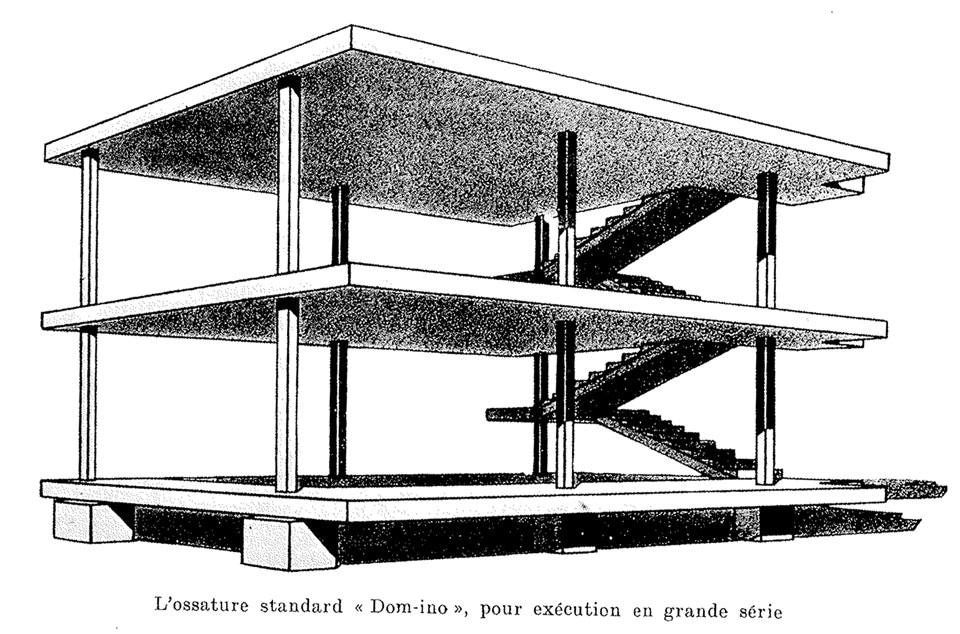
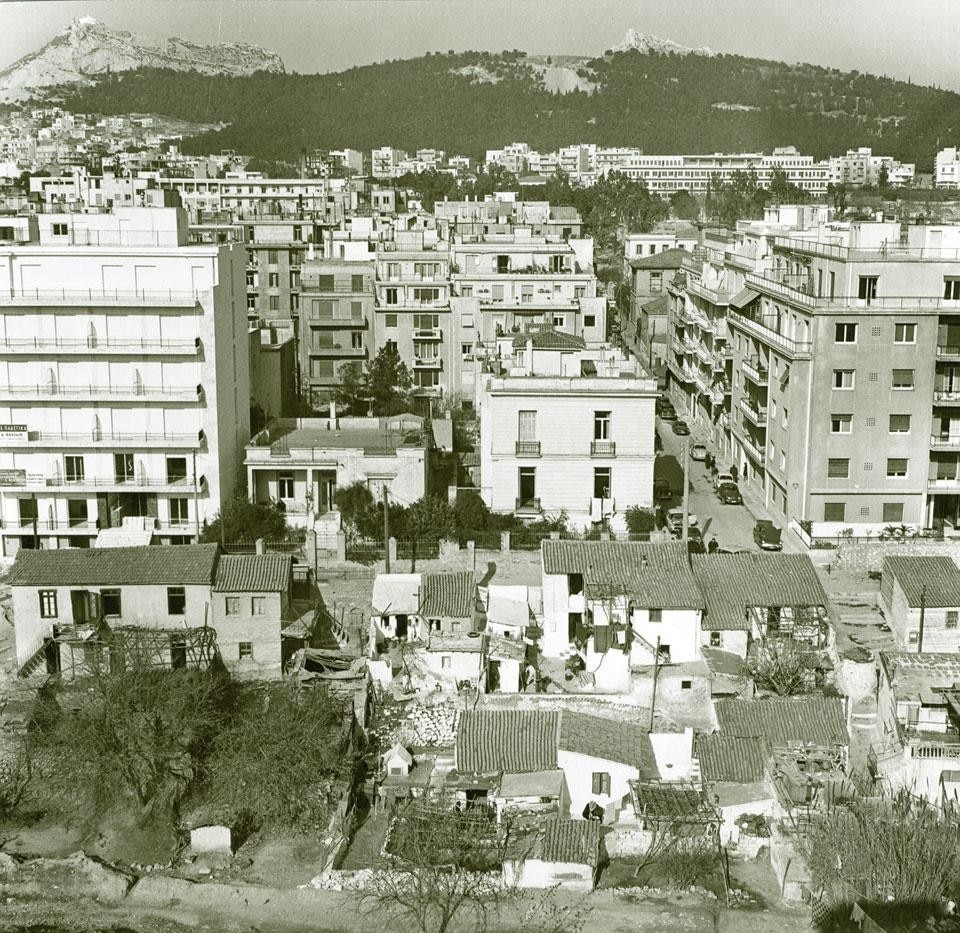
The polykatoikia was originally conceived in the 1930s as a multistorey apartment building for the Athenian bourgeoisie [3]. The proliferation of this type was supported by the State in the form of a general building regulation and a property law [4], which directly produced the basic rationale behind the architecture of the polykatoikia. This law allowed landowners to barter tax-free their buildable ground in exchange for built indoor space, effectively deregulating the construction industry. Another goal of the polykatoikia as promoted by the State was to advance (and thus appropriate) local construction knowledge towards a coherent and yet flexible system of building techniques, materials, details and structural schemes. Like in the Dom-ino model this system combined advanced industrial solutions with low-skilled manual labour. Through the apparatus of the polykatoikia, the project of the city was advanced no longer through top-down master planning, but through the production of abstract legislative frameworks, which materialised in the bottom-up practice of self-building.
This building logic was extensively mobilised with the post-war reconstruction of Athens. After World War II, Greece entered a bloody civil war that ended with the defeat of the Communist forces. The new "democratic" government put forward a plan to tame the rebellious potential of the working class. A fundamental issue was to avoid big industrial concentrations and encourage a small-scale building economy in order to fragment and thus control the population. By advancing the small-scale building system of the polykatoikia, the government promoted the reconstruction of the country and the consequent economic recovery with minimum state intervention [5]. In this way increasing housing needs were met without a welfare programme [6], while a large part of the population was guided towards private ownership [7]. The generic form of the polykatoikia was able to absorb all classes and allow any kind of infill and thus became a type suitable for all sorts of urban densities.
The polykatoikia was originally conceived in the 1930s as a multi-storey apartment building for the Athenian bourgeoisie
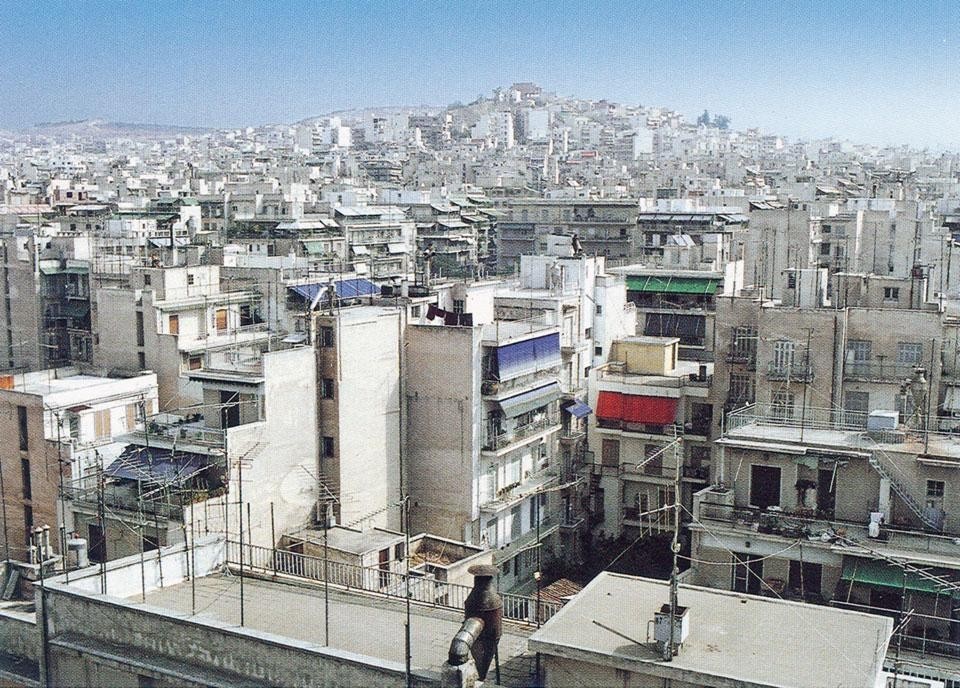
At the same time the architecture of the polykatoikia itself, with its small scale and lack of collective spaces, has developed an urban ethos completely locked within its extreme individualism. And yet if the politics of post-war Greece were advanced through the architecture of one single archetype it is precisely by altering this archetype that it is possible to promote a large-scale reform of the city without recurring to a master plan. An important premise of this reform is to show how in spite of the urban fragmentation, the polykatoikia, as an architectural language, manifests itself (in its utmost radical intensity) as a common and thus deeply collective construction system. The fundamental goal of this reform would be to overcome the fragmentation provoked by the application of this building type, by working towards a reconstruction of collective urban formations.
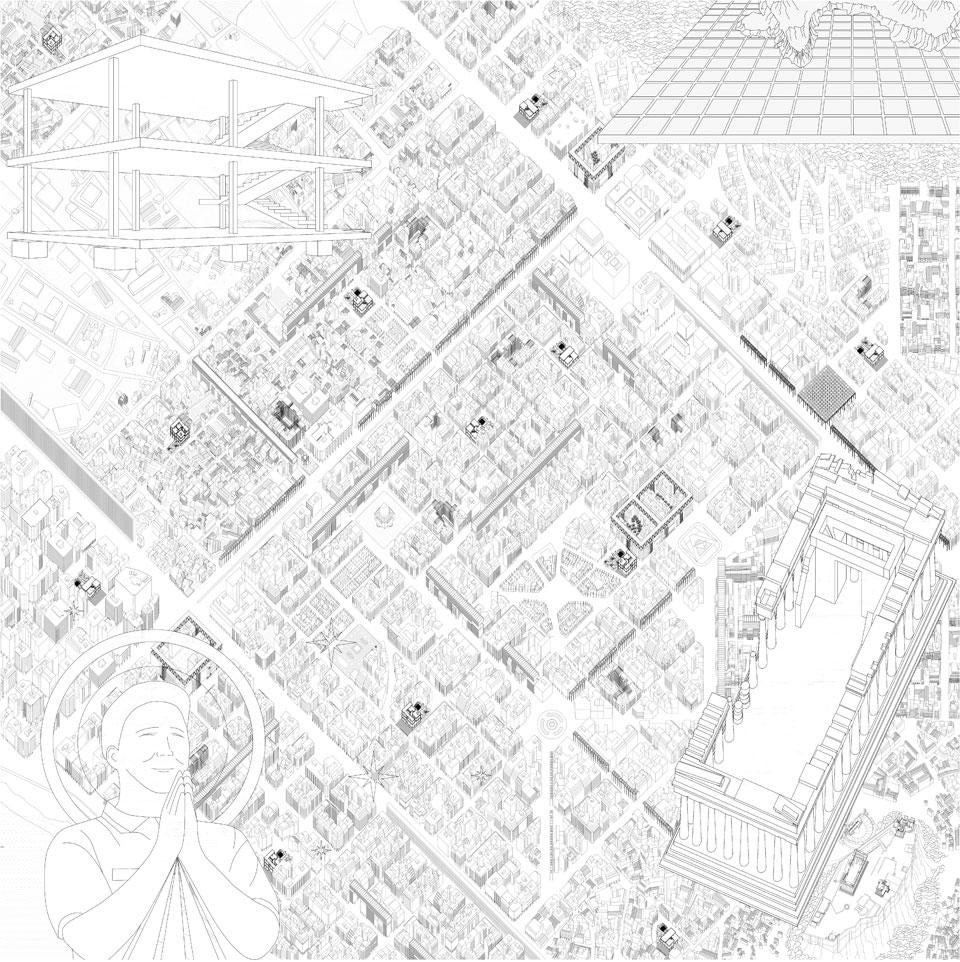
In the financial and urban crisis that Athens has been undergoing since 2008, we have developed at the Berlage Institute a project that starts from a critical evaluation of the polykatoikia protocol and the subjectivity it has produced. Both the economic rationale and the social functioning of the urban condition created by the polykatoikia have shown their limits. The disastrous current situation makes the rethinking of this model a very urgent task. With this project we aim to expose the generic nature of the polykatoikia, while recovering the architecture of the city beyond the pixel of the single dwelling. Instead of a master plan we propose a catalogue of architectural actions that aim to connect the fragmented dwellings into coherent and formally finite collective urban forms. These forms are the courtyard, the block, the street, and the most collective layer of the city: the ground floor. The flexibility and openness of the polykatoikia is thus manipulated towards the opposite scenario for which it was developed. While the Dom-ino approach encourages the individual house owner to become an independent entrepreneur who fills in, organises and manipulates his part of the skeleton, the forms we propose all imply a form of collective will and collaboration. The courtyard, the block, the street, and the ground floor become figures that can be rescued from the polykatoikia carpet. Our proposal radicalises these figures into distinct architectural archetypes.
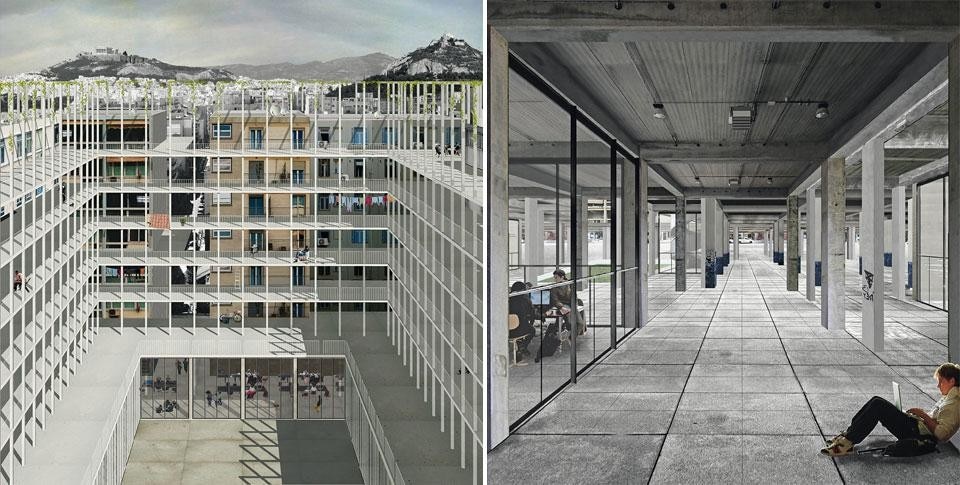
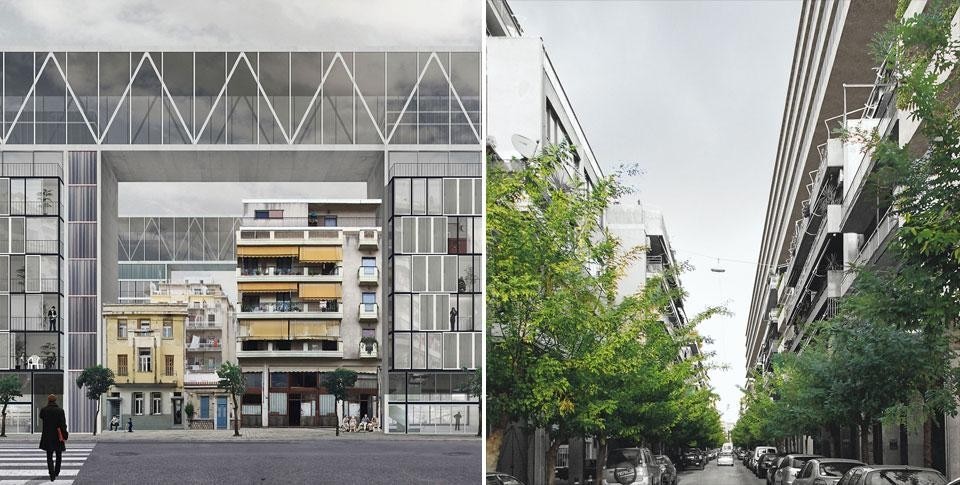
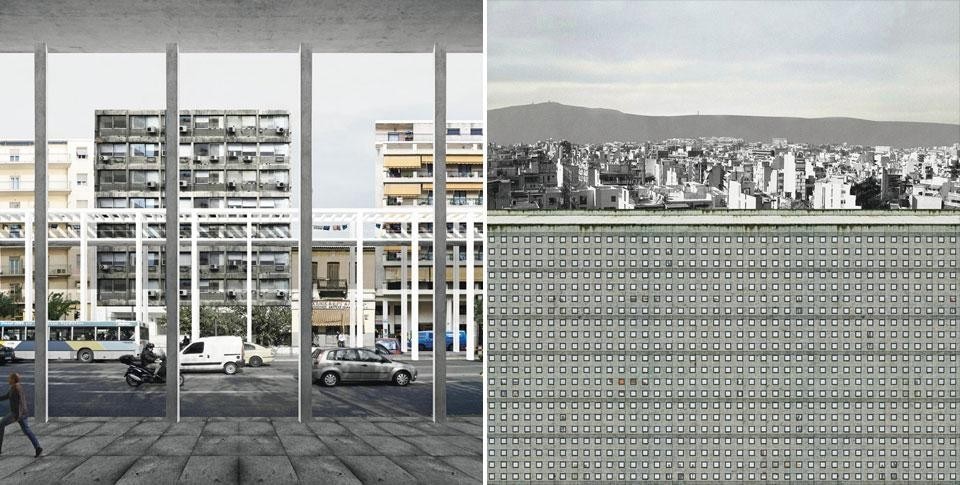
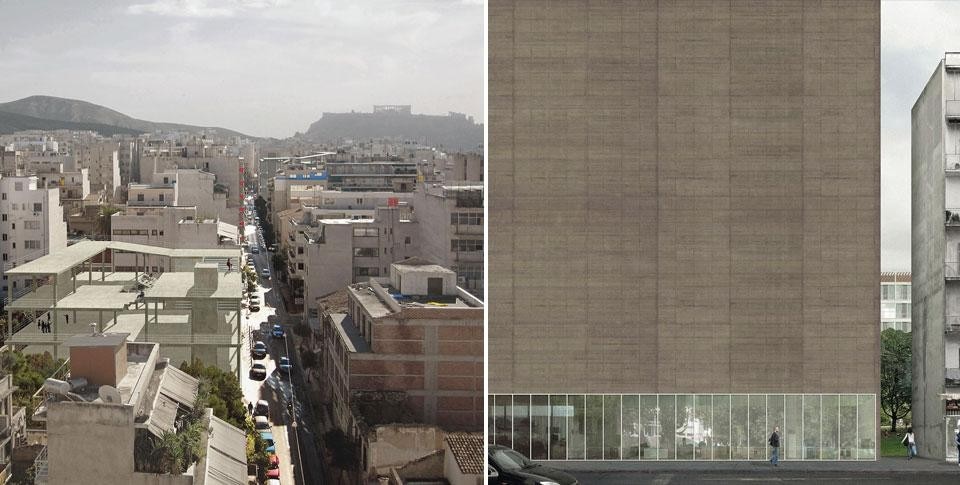
1. The term poly-katoikia is a composite word, from poly, translated as multi, and the noun katoikia, dwelling. In Greek, polykatoikia stands for the multi-storey apartment building, eventually becoming a term that describes every housing building except for suburban single-family villas.
2. See Adolf Max Vogt, Le Corbusier, The Noble Savage, The MIT Press, Cambridge 2000.
3. For a thorough analysis on the birth and the evolution of the polykatoikia type in the 1920s and 1930s see Dimitris Emmanuel, The Growth of Speculative Building in Greece: Modes of Housing Production and Socioeconomic Changes, PhD Thesis, London School of Economics and Political Science, London 1981.
4. See "The General Building Regulation of the State" (April 3rd 1929) and the 3741/1929 law "On Horizontal Property Divisions and other provisions".
5. On the particularities of this economic model (in Greek): Panos Kazakos, Between State and Markets: Economy and Economic Policy in Greece, 1944-2000, Patakis, Athens 2009.
6. Dimitris Emmanuel, Housing Public Policies in Greece: The Scale of an Absence, National Centre for Social Research, Athens 2006.
7. This particular process and the political implications of this economic project were thoroughly discussed and described in a fundamental text of 1951, the report "On the Economic Problem of Greece", by the Greek economist Kyriakos Varvaressos. The report foresaw and analysed the particularities of this major reform. Recently republished (in Greek): Varvaressos, Kyriakos, Report on the Economic Problem of Greece, Savalas, Athens 2002.
8. N. X. Rousanoglou (in Greek), "84.6 is the Percentage of Home Ownership in Greece", Kathimerini, 04/01/2006, figures from the General Report on the Activities of the European Union-2005, European Commission Brussels, Luxembourg 2006.
9. As an example, we refer to the essay by Paolo Virno, "Virtuosismo e Rivoluzione", in Mondanità, Manifesto Libri, Rome 1994.




